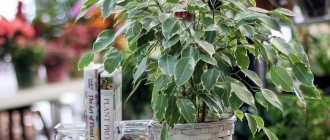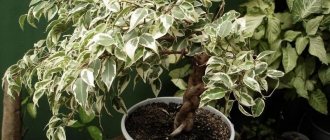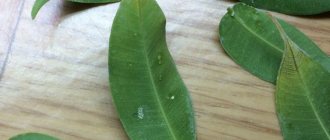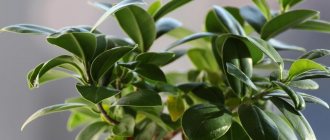Ficus benjamina - a tree-like shrub, originally from the tropics, which, even in an apartment, can grow into a full-fledged tree, 2-2.5 m high. If such a large size is not included in your plans, then its growth can be easily restrained by the volume of the pot and timely pruning. Then it will easily fit on any windowsill.
Despite its tropical origin, the plant is very pliable and does not require special attention at all. Still, Ficus Benjamin has some needs that need to be kept in mind when caring for it at home. By following them, you can grow a beautiful bush or tree, for example, as in the photo below:
Ficus benjamina will not only decorate your home, but also purify the air!
Briefly about care
Temperature in summer +18º - +25º, in winter from +16º Air humidity is high Lighting is moderately bright, diffused Where to put the eastern, south-eastern, western, south-western, southern window sill Watering in summer 2 times a week, in winter - 1 time a week soil with sand and coal Feeding and fertilizing once every 14 days from spring to autumn with organic and mineral preparations Replanting annually in spring Propagation by cuttings, layering, seeds
4.Lighting and location selection
The sun is certainly necessary for Ficus Benjamin, but direct burning rays should be avoided. Specimens with variegated leaves will especially suffer from a lack of sun; in the shade they will become greener and the white veins will not be visible.
In addition, under the bright sun, ficus can get severely burned. Therefore, the best place for ficus will be windows facing east and west. As for Benjamin's ficuses with dark-colored leaves, they will feel great in the shade and in the back of the room, far from the window.
For ficus it is very important that the lighting is the same on all sides, otherwise the crown will not be symmetrical. In order for the proportions to be maintained, it is worth rotating the plant once a month around its axis by 20 degrees, this is very important.
How to care after purchase
When purchasing, it is important to carefully examine the ficus, make sure that the soil is not over-moistened and does not emit an unpleasant odor. Choose a comfortable place for the plant: well-lit, warm and windproof.
Try not to move it from place to place often. It is advisable to spray the leaves and water the soil with Gumi-20 (2 drops per 200 ml) and quarantine for a week away from other flowers.
Replant no earlier than two weeks later to allow the flower to get used to the new conditions. If the plant does not get sick during this period, it is advisable to replant it, since store-bought soil is not intended for long-term cultivation.
After transplantation, you cannot use fertilizing for a month. Adjust watering: during the adaptation period, it is especially important not to overwater the ficus.
Don’t worry if you can’t perfectly comply with some conditions for caring for the plant: ficus benjamina is quite unpretentious and will forgive you for mistakes.
What to do if ficus benjamina drops leaves
If you are faced with the problem of dropping leaves, then pay attention to the soil: a lack of moisture affects it just as bad as waterlogging. Foliage may also fall if there is a high level of air dryness, temperature changes, or the tree is standing in a too cold room. Do not forget that this royal flower is not watered with cold water!
If you do everything right, your trees will look divine!
We have discussed the basic steps for caring for this plant. We hope that our recommendations will help you eliminate mistakes when raising your pet.
FAQ
Is it possible to leave without care while on vacation?
It is not advisable to leave the ficus for longer than 1 week. At this time, it should be removed from the windowsill so that the plant does not get burned if it is very sunny in your absence. And ask your friends to water your plant. Read more about watering here.
What to do if ficus benjamina drops leaves
The plant gets rid of old leaves within the normal range. However, just in case, adjust the temperature in the room and provide additional lighting. Sometimes a plant falls off if it is moved to a new location or due to drafts.
Or the reason may be more serious: the roots have rotted from excessive watering. In this case, you need to remove the ficus from the pot, cut off the spoiled roots, sprinkle the sections with crushed activated carbon and replant them in a smaller pot with a complete replacement of the soil.
Flowers on ficus benjamina: is it possible?
Rarely blooms at home. If, nevertheless, pea-shaped inflorescences appear on it, then it is better to cut them off, especially if the plant is in poor condition: the ficus spends too much energy on flowering.
Plant pruning
Of course, every gardener wants to be the owner of a beautiful plant, so pruning ficus benjamina cannot be avoided in any way. It is produced with the following goals:
- formation of a spectacular crown:
- ficus rejuvenation;
- sanitization.
A beautifully decorated ficus benjamina is a decoration for any home. In order to give the crown its original shape, it is necessary to carefully trim the top and side branches. It is better to come up with an image in advance of what the plant will ultimately be like, while taking into account the characteristics of the shoots and how they grow, so as not to harm them. Often the process of forming a crown, which can be in the form of a pyramid, a circle or a bush, turns into real creativity.
In order for the ficus benjamina to actively develop, its old branches should be disposed of in a timely manner. In this way, the younger parts of the plant are stimulated to grow, and rejuvenation occurs. Sanitary pruning is based on almost the same thing, which is done to remove yellowed, damaged or obviously infected leaves. This helps to stop the spread of infection and reduce the ardor of pests attacking the ficus.
An important nuance - it is advisable to carry out pruning when the ficus is at rest. In the active growth phase, the loss of foliage or entire shoots can be too critical. To perform this procedure you need:
- pruning shears, knife or regular blade;
- Activated carbon;
- alcohol solution.
In principle, the choice of tool is not so important, the main thing is that it is sharp. To remove small shoots, you can use miniature scissors - they will be most convenient to use. Everything must be done extremely carefully, and the cut areas must be immediately coated with activated carbon. To disinfect instruments, you will need an alcohol solution to prevent all kinds of bacteria and viruses from entering the plant tissue.
Spraying
Requires daily abundant spraying, especially during periods of low humidity: hot summer and heating season. To increase air humidity, you can place a saucer with water and expanded clay next to the ficus.
In the hot season, give the plant a shower - after that, do not rush to return it to the windowsill, but first let it dry a little so that sunburn does not appear on the leaves.
For spraying, use settled water at room temperature. Wipe dusty leaves regularly.
Signs of improper watering
You will notice the consequences of improper watering quickly. If watered incorrectly, the leaves turn yellow completely or at the edges, dry out, and fall off profusely. Excessive and insufficient watering is equally harmful to the plant.
What happens if there is a lack of moisture?
If you notice that the young leaves are small, do not have time to develop and immediately fall off, the old ones begin to turn yellow completely, and the growth of new shoots stops, then you need to increase the frequency of watering. These are clear signs of water shortage. The plant becomes vulnerable to diseases and parasites. If it is not winter, it may be necessary to increase feeding to restore the viability of the ficus.
If you have missed several waterings and the soil has become excessively dry, immerse the pot in a container of water and wait 10-15 minutes until air bubbles stop appearing on the surface of the water. Check the soil moisture in the pot and allow the moisture to drain.
What happens if there is an excess?
- If ficus leaves fall regularly, especially the lower leaves, but in small quantities, this means that there is rather a lot of moisture rather than a little. Take care to reduce the intensity of watering.
- Yellowing of the edges of the leaves also indicates excessive watering.
- Another sign is rot. A powdery white coating becomes noticeable on the roots near the trunk. To stop putrefactive processes, it is necessary to loosen the soil and reduce watering.
If the plant is flooded, it is necessary to transplant it into disinfected soil. The surface of the soil can be sprinkled with crushed activated carbon. Treat the roots with a weak solution of potassium permanganate. Trim damaged leaves. If the flood is very heavy, you can not water the plant for 1-2 weeks, limit yourself to spraying the leaves.
Illumination
Loves moderately bright diffused lighting. Grows well on windows facing east or west.
Install shading on southern window sills - hang curtains, blinds or cover the window with film, which can be bought at a hardware store - otherwise, due to direct sunlight, burns in the form of light spots may appear on the ficus.
When placing the ficus on a north window, provide it with additional lighting in the form of a phytolamp, otherwise its branches will become thinner and it will grow poorly.
Varieties with dark leaves tolerate partial shade well, while variegated varieties need bright light due to the low amount of chlorophyll.
Suitable soil mixture
A neutral or slightly acidic substrate with high fertility is best. You can purchase a universal soil for decorative foliage plants; a substrate for palm trees or mulberry plants is also suitable.
Or prepare the soil mixture yourself. To do this, you need to mix equal parts turf and leaf soil, add sand and peat or charcoal.
To check the acidity, sprinkle a damp lump of soil with soda: if gas is released, then the soil is highly acidic. Moisten another lump of earth with vinegar: if the substrate hisses, the environment in it is alkaline.
Neutral soil will not give any reaction to any of the manipulations. You can put ash to eliminate the acidity of the substrate. Line the bottom with a layer of expanded clay for drainage.
Top dressing
Use mineral (Epin at a dosage of 1 ml per 5 liters of water) and organic (manure at the rate of 1 g per 1 liter of water, bird droppings - 5 g per 1 liter of water) fertilizer for ficus or ornamental foliage plants 2 times a month from March to September.
It is advisable to alternate them. You can not only sprinkle the soil with fertilizer, but also add it to the water for spraying the leaves and generously moisten both the foliage and the trunk.
In winter, give the plant a break from fertilizers to provide it with an artificial dormancy period. It is also better to refrain from fertilizing for a month after transplantation.
In addition to chemicals, you can also use folk remedies: dilute 1 tbsp. sugar in 1 liter of water and use it for watering (it is enough to apply this fertilizer twice a season).
Fertilizers and feeding ficus benjamina
After transplanting or partially replacing the substrate for six months, Ficus Benjamin does not need additional feeding. Excess nutrients in the soil will only harm the plant. You can feed the flower during the growing season: from mid-March to the end of September. To do this, use liquid all-purpose fertilizers for decorative leafy indoor plants dissolved in water.
Apply fertilizing in the morning once every two weeks. You can also dissolve the fertilizer in water, pour it into a spray bottle and spray the flower once every 10 days. Keep in mind that nitrogenous fertilizers, if used frequently, will cause the variegated leaves of the Benjamin ficus to turn simply green.
Photo: flo.discus-club.ru
Indoor begonia: home care, propagation and transplantation
Transfer
A plant up to 4 years old must be transplanted into a new pot every year in the spring. Select the diameter of the pots 2-3 cm larger each time.
An adult plant can be left in an old pot, partially replacing the soil in it when the roots become crowded. This can be understood by the roots peeking out of the drainage holes and the rapid drying out of the soil.
A ficus older than four years old requires transplanting into a new pot only if the roots have completely entwined the earthen ball and the substrate dries out quickly after watering.
We replant using the transshipment method. To do this, take the flower out of the old pot and replant it in new soil, without shaking the old substrate from the roots too much. Place a layer of expanded clay on the bottom of the flowerpot to ensure drainage.
Sprinkle with a fresh layer of soil. In hot weather, you can water the plant a little right away, otherwise wait a few days.
Important: after transplanting, remove fertilizing for a month.
Where to put
On the east, south-east, west or south-west window or away from the window if it is on the south side.
In summer, you can take the ficus outside, onto a balcony or onto a veranda, but if night temperatures drop below +16º, it is better not to do this, otherwise the plant may catch a cold.
Ficus with monochromatic leaves tolerates partial shade well, but a plant with spotted and white leaves must be placed in the light: they do not produce chlorophyll well. Keep the flower away from drafts and radiators.
7.Pinching and trimming
Pruning can be sanitary or rejuvenating. Sanitary pruning is carried out as necessary, old, dried and diseased shoots are removed. This will protect the ficus from diseases and the spread of pests. Remove diseased branches with sharp scissors or pruners. Sanitation thins out the crown and allows light to penetrate to the internal branches.
Anti-aging pruning is needed for old ficuses and those that have lost their beautiful appearance. This procedure will allow the ficus to quickly grow and grow new foliage.
This type of pruning is most important for ficus plants with long shoots that have lost their leaves due to unfavorable conditions, drafts, lack of moisture or light.
Pinching the tops of young shoots with 1 or 2 leaves is carried out in the spring so that the crown of the plant is ideal and bushy. Pinching is done with sharp scissors or fingernails. I don’t recommend doing these manipulations in winter; wait until spring.
Pruning and crown formation
Ficus is pruned to give it an aesthetic appearance and to rejuvenate it. In spring, shorten the branches, leaving 10-15 cm and thin out the crown, especially if the branches grow inside the bush.
You can also remove all side branches, forming one strong trunk. Treat cut stumps with potassium permanganate or activated carbon powder. It is also possible to weave the stems into a braid and create a ficus bonsai.
Braiding stems
This should be taken care of even at the stage of planting cuttings in a pot. Place 3-4 seedlings at once in one pot. They must be at least 13 cm long so that they can be braided.
Trim the side branches from the trunks and water the plant 10 hours before weaving begins. The density of the braid can be adjusted by inserting sticks into the gaps, which will need to be removed later, when the plant gets used to the new shape.
Tie the braided fragment with woolen thread to fix the branches in the desired position. As the ficus grows, add more braiding.
Sometimes, when the trunk reaches a great length, it is necessary to install a support so that the ficus does not fall to one side. To do this, place a stick in the pot and tie the stems to it in one or several places, depending on the height of the plant.
Compositions in bonsai style
To do this, it is important to immediately choose the right pot: it should be wide and low, like a tray, and always have holes in the bottom for drainage. The Exotic variety is best suited for forming a bonsai (it has developed roots, a beautiful trunk, small leaves, and it grows quickly).
- At the bottom we lay out a layer of drainage, a layer of river sand and a layer of soil.
- We trim the roots so that they are not crowded in the pot and cut the branches to a length of 15 cm.
- We plant it in a substrate, water it and place it in partial shade for 2 weeks.
- As it grows, we trim the main trunk, making a cut above the upper bud so that the ficus does not stretch upward, but grows to the sides.
- As the roots and trunk grow, once a year we transplant it into a wider pot. When the trunk reaches the desired thickness, replanting can be stopped.
- To form curved branches, we tie them to the trunk with supports. Gradually they will learn to grow in a certain direction without outside help, and the tying can be removed. It is also possible to use thin wire with insulation, which is wrapped around the barrels, fixing them in the desired position. When the ficus learns to grow as required, carefully cut the wire and remove it.
Important: the soil in low, wide pots dries out faster, so it is recommended to water and spray the ficus daily in small portions.
Rules for watering ficus
Growing ficus is not difficult for a novice gardener. You just need to remember a few simple irrigation rules.
Recommendations on how to properly water a ficus:
- Change watering regimes depending on the season. The quality of its growth will depend on how often you water your ficus.
- Clean water is used for watering ficus, at a temperature of 20-25°C.
- When irrigating the plant, the root area of the soil should be completely wet.
- The tree should be moistened early in the morning or after sunset.
To remove excess moisture, it is necessary to provide drainage at the bottom of the tub. Crushed red brick or expanded clay is used as drainage.
What you water your ficus with is of great importance. The liquid for irrigating the plant should be at room temperature at any time of the year. Using very warm or cool water will damage the roots.
Reproduction methods
Ficus benjamina can be planted by cuttings, layering appearing on the trunk, or grown from seeds.
The easiest way is to plant cuttings: this is the method that is most likely to be successful. It is best to do this in the spring.
Cuttings
To do this, we cut off a lignified cutting 10-12 cm long, wash off the juice from the cut and dry it, then make a notch on it to accelerate root germination.
Place the cutting in water so that the leaves do not get wet. To avoid rotting, you can dissolve ½ tablet of aspirin or activated carbon in water.
The root should emerge in 1-2 weeks. You can make a greenhouse by covering the plant with a glass jar.
After the roots have sprouted, we plant them in the soil and cover them with a plastic bag.
When a new shoot hatches, we remove the greenhouse. The cutting can be rooted directly in the soil, bypassing the stage of root germination in water.
How to propagate by layering
We make a round cut on the trunk and remove the bark, after which we apply wet sphagnum and wrap it with polyethylene. When roots grow in this area, you need to cut off the top and plant it in the ground.
Growing from seeds
The seeds can be soaked in water for a day, or they can be planted directly into the substrate in a dry form. The soil must first be wetted and the seeds must be buried to a depth of one and a half centimeters.
You can put the seeds on a radiator to speed up germination. The ficus should sprout in a couple of months.
Reproduction
Ficus benjamina is propagated by cuttings.
The best time for this is spring, when it becomes warm and all processes in the plant body proceed at an accelerated pace. But still, the process of root emergence in Ficus Benjamin cannot be called quick. Under favorable conditions (warmth, favorable humidity), spring cuttings take root in 2-3 weeks. In more difficult conditions, this process can take a month or more.
To propagate Ficus Benjamin by cuttings, do the following:
- Using a sharp knife, cut the apical young cuttings (non-lignified or semi-lignified) from the plant. The length of the cuttings should be 10-15 cm.
- A milky juice is released at the cut site - rinse it off under running water or immediately place the cutting in a glass of water for 1 hour. Then dry the cut in a dry place for several hours. Milky sap inhibits the emergence of roots in ficus, so you should not neglect to wash it off.
- Tear off the lower leaves on the cutting. When buried in soil or water, these leaves will most likely begin to rot, thereby spreading bacteria to the rooting cutting.
- To stimulate the formation of roots and make this process faster, dip a cut of the cutting in Kornevin. This stage is not mandatory, but highly desirable, especially in non-ideal rooting conditions.
- Place the cutting in warm water or bury it 1.5-2 cm in the ground. A more successful soil option is peat tablets, in which roots form faster.
- To root cuttings, choose a warm (more than 25°C) and bright place, without direct sunlight. High air humidity is also important - ideally about 80%. To increase this parameter, the easiest way is to build a greenhouse over the rooted cuttings, that is, cover it with a plastic cup, bag, etc.
After cutting, ficus cuttings are buried in the ground, where they will take root
. For reference:
In autumn and winter, the rooting of any plants, including ficuses, may not take place at all. At this time, the plant is preparing or is already dormant; another unfavorable factor is cold. The cutting will be in a half-asleep state and will most likely rot.
Diseases and pests
Ficus can get sick if it is not watered regularly, gets cold, is under- or over-fed, or is provided with insufficient or excessive light.
Lumps on leaves
You are flooding the soil too much. The roots can rot, so they need to be removed from the pot, cut off the damaged parts, sprinkled with activated carbon powder and replanted in fresh soil. As a preventive measure, reduce watering.
Leaves wither and curl
This is a sign that the plant is freezing. Remove it from a cold windowsill and avoid drafts. Another possible reason is low air humidity - start spraying the ficus.
The tips of the leaves turn brown
This indicates a lack of moisture. Start spraying the leaves and remove the ficus from the radiators. You can also increase the air humidity in the room by placing a saucer of water next to the flower, hanging a damp towel on the radiator, or purchasing an air humidifier.
Thinning of young shoots
This occurs with a lack of light and feeding. Place the ficus on a well-lit windowsill or purchase a phytolamp for it, and also start using mineral fertilizers (Agricola in a dosage of 1 tsp per 2 liters of water) once every 2 weeks.
Yellowing of ficus benjamina leaves
This is a sign that you are flooding the plant and its roots are beginning to rot. Remove the plant from the pot, remove bad roots, remembering to treat the wounds with charcoal powder, and then replant it in new soil. As a preventative measure, reduce watering.
Leaves become soft
This happens when the plant freezes. Remove it from a cold windowsill or place it on a stand. When airing, take it to another room.
Spots on leaves
Yellow or brown spots are sunburn. Do not expose the plant to direct sunlight; install a shade on the southern windowsill.
Yellowing along the edges of the sheet
The plant lacks fertilizer. Add nitrogen fertilizing (Agricola at a dosage of 1 tsp per 2 liters of water) once every 14 days.
The foliage is drying
This happens in winter due to lack of lighting and air humidity. Provide the ficus with additional lighting using a phytolamp and increase the number of sprays, or install an air humidifier in the room.
You can also increase the humidity using old-fashioned methods: place a saucer with water and expanded clay near the pot or cover the radiator with a damp towel.
Botrytis
A white coating on the leaves will indicate its appearance. Remove the damage and treat the leaves with a fungicide (Fitosporin in a ratio of 1:20). If a single spraying does not help, repeat it after 10-12 days. It is also recommended to reduce watering during treatment.
Cercospora
Dark spots on the back surface of the foliage. Because of it, the plant may wither. Remove damage, treat with furatsilin: dilute 1 tablet in 100 ml of boiling water, cool to room temperature and spray on leaves. Remove the plant until it recovers.
Anthracnose
The edges of the leaves dry out and brown spots appear. Remove damage, treat with copper sulfate: 1 tsp. dilute in 2 liters of hot water, cool to room temperature, spray the leaves and water the soil. Place in quarantine for the duration of treatment. Repeated treatment is carried out after 1.5 - 3 weeks. It is also important to reduce watering during the treatment period.
Sooty fungus
It is a dark film resembling a soot coating. Because of it, the plant cannot breathe normally, which is why it begins to grow more slowly and weaken. Wash off the plaque with a damp cloth and give the plant a warm shower.
Remove the affected parts of the plant and treat all its parts, including the roots, with Aktara fungicide, diluting 1 g per 1.25 liters of water. To prevent fungal diseases, you can water the soil once a month with a weak solution of potassium permanganate.
Mealybug
White fluffy lumps on cuttings. The roots can also be affected, but this can only be known during transplantation or if the plant begins to wither.
Wash off in the shower, covering the soil with a bag, treat with insecticide: Confidor at the rate of 1 g per 1 liter of water, spray the foliage and spill the soil, repeat the procedure with Aktara in a week at a dosage of 1 g per 1 liter of water.
Shchitovka
Brown tubercles on the back surface of the leaves. Rinse off in the shower, covering the soil with a bag, treat the leaves on both sides with Actellik (2 ml per 2 liters of water) 3-4 times with an interval of 7 days. The drug is toxic, so it is advisable to carry out the treatment outdoors.
Spider mite
It appears as small red and brown dots crawling along leaves and branches. At later stages of damage, they are indicated by the appearance of cobwebs on the plant. Rinse off in the shower, covering the soil with a bag, treat the leaves on both sides with an insecticide: Actellik (2 ml per 2 liters of water), Aktara (4 g per 5 liters of water), Fitoverm (10 ml per 1 liter of water). Repeat the procedure three times every 10 days.
Aphid
Small green or black insects that attack the inside of leaves. Treat the plant with a soap solution three times during the week or spray the leaves on both sides with an insecticide: a solution of Bordeaux mixture (100 g per 10 liters of water, use no more than three times at weekly intervals), pyrethrum (2 g per 1 liter of water, treat 3 times). 4 times with a break of 5 days).
Thrips
They can be identified by shiny white spots on the outside of the foliage. The insects themselves settle on the underside and have bodies up to 1.5 mm long that are brown, black or gray.
Adults can be removed with a vacuum cleaner, and larvae with a cotton swab. It is advisable to transplant the flower into new soil, first disinfect the pot or purchase a new one. Can be treated with chemicals: Agravertine (10 ml per 1 liter of water). It is important to spray the entire plant.
Nematodes
These are invisible insects that attack plants, causing their leaves to stop developing, wither and become spotted. The chemicals used to control nematodes are toxic and should not be used indoors. The best solution is to throw the plant away.
If you still have the opportunity to treat the plant in the fresh air: dilute Actellik (2 ml per 2 liters of water) and spray the entire plant, and also immerse the roots in the solution. After this, you need to transplant it into new soil, having first disinfected the pot and the place where the ficus stood. This can be done with a solution of potassium permanganate, vinegar essence or soda-salt solution.
To avoid damage by this pest, the soil must be calcined before planting. To do this, pour the soil into a basin and pour boiling water over it, then place it on a baking sheet in a thin layer and heat in the oven for half an hour at a temperature of 70-90 degrees.
How to care for ficus benjamina at home
Flower growers fell in love with Benjamin for his simple character. If you follow a few rules, this plant will be a worthy decoration for your home’s green corner.
Lighting
Ficus benjamina requires plenty of sunlight when growing, but the plant does not tolerate direct sunlight. It can be placed on the windowsill of an eastern or western window, and larger specimens can be placed near southern windows. On a northern window, due to lack of light, growth slows down and the crown thins out.
Varieties whose leaves are decorated with many light spots require much more light, otherwise they will begin to lose their beautiful color. Such specimens may require additional lighting with fluorescent lamps or special lamps for plants.
Temperature
The Benjamin tree is quite thermophilic, but can easily grow at normal room temperature. The optimal maintenance temperature in the warm season is about +18-+250C. In winter, the temperature in the room should not fall below +160C. The plant does not tolerate drafts, so to prevent the flower from freezing, it is taken to another room during ventilation, since the plant sheds its leaves when exposed to cold air.
It should be borne in mind that variegated varieties of Ficus benjamina need warmer maintenance and are extremely critical of temperature changes.
Humidity
The room where Ficus benjamina grows should have high humidity. It can grow at normal humidity typical of a living room, but you need to regularly spray the crown with warm water from a spray bottle. The leaves of the tree dry out from the hot air when heating devices are operating, so in winter it is removed away from the radiators. You can increase the humidity using a household humidifier; you can also place a flower pot on a tray with expanded clay or wet moss.
Watering
Water the Benjamin tree abundantly, but without allowing the substrate to become waterlogged. Water for irrigation should be soft, at room temperature.
In summer
In the warm season, water every 3-4 days. Watering should be plentiful, as the contents of the pot dry out 3 cm deep. The earthen ball should not be allowed to dry out, as in this case the growth of Ficus Benjamin will stop and it will begin to lose leaves.
in winter
In winter, watering is reduced to moderate. The soil in the pot is moistened approximately once a week, as the top layer dries.
Fertilizer and feeding
From March to October, Ficus Benjamina needs special feeding. Fertilizers are applied 2 times a month, and you can use complex mineral fertilizer or alternate it with organic matter.
When choosing a preparation, it is important to pay attention to the ratio of components, since a high nitrogen content can lead variegated varieties to a completely ordinary monochromatic appearance and loss of characteristic spots. In flower shops you can find special fertilizers for ficus plants. Agricola for Ficus benjamina can be an excellent feeding option. It is used according to the instructions, strictly observing the dosage.
Fertilizers can be applied to the soil or on the leaves. For this you can also use special preparations and mineral fertilizers, but in weaker concentrations.
Special feedings will help not only stimulate the growth of the flower, but also help it recover after a change of place of residence or illness. In order for the plant to better withstand stress, it is sprayed and watered with succinic acid or epin. Succinic acid for Ficus Benjamin serves as a good antidepressant and helps to recover, even if it has lost most of its leaves. It is diluted with water and applied along with watering or sprayed on the crown in a more reduced concentration. After some time of this “therapy”, the ficus comes to life again and begins to actively grow green mass. How to breed Epin for Ficus benjamina can be found in the instructions. This drug has a complex effect and is used for many indoor and garden crops. Just 3-4 drops per 1 liter of warm water are enough to water the bush, after which it regains its vibrant appearance and gradually regains its attractiveness.
Pruning and crown formation
Ficus benjamina lends itself well to pruning and crown shaping. You can create a beautiful shape simply by periodically removing overgrown branches. Usually the plant is given the shape of a lush bush, every spring shortening the main branches to 15 cm and the side branches to 10 cm. The bush will quickly restore its shape and begin to actively increase the lost volume. All branches growing inside the crown are pruned so as not to disrupt air circulation.
To give the Ficus benjamina the shape of a beautiful tree, remove all the side branches on the main trunk. For uniform development of the crown, you need to periodically turn the flower pot in relation to the light source, then the ficus will develop evenly on all sides.
If you need to stimulate the growth of lateral branches on the trunk, you can resort to a little trick and use special means. Cytokinin paste for Ficus Benjamin serves as a stimulator for the awakening of dormant buds. She does an excellent job even if the bush has been significantly damaged by a draft or improper care. To do this, just make small cuts on the trunk of the plant and apply a small drop of paste onto them with the tip of a toothpick. After some time, new branches will begin to appear on the trunk. Just keep in mind that cytokinin paste stimulates the growth of new shoots, but in order for them to grow and develop well, the plant must be well fed and provided with everything necessary for vigorous growth, otherwise new branches will grow disproportionately and may disrupt the decorative appearance of the Benjamin tree. Also, when using special means in variegated varieties, new branches often grow with monochromatic leaves.
How to braid a trunk
The thin and graceful stems of Ficus benjamina are often used to create real living sculptures. The beautiful columns of intertwined trunks of this plant look very attractive, while the ficus does not suffer at all and continues to grow. Weaving Ficus Benjamin is not a complicated process, but it requires a lot of patience, since the formation of an openwork trunk does not occur in a few days, it will take months and even years.
To do this, you need to take several ficus cuttings and plant them in one pot. The planting density depends on the desired result: if you need to tightly intertwine the stems to get a tight twisting trunk, then the seedlings are planted close to each other, at a distance of only 5-10 cm, and when creating an air column, the distance can be increased.
As the seedlings grow, they are braided, secured with plaits and tied with electrical tape. Tightly planted plants are carefully twisted in a spiral and secured. Over time, they will grow together into one dense and beautiful trunk.
Openwork columns are created by crossing and securing young ficus trees. In the middle of the plantings, it is advisable to place a pipe made of plastic or cardboard, around which patterns will weave. In this case, you need to constantly remove all excess lateral growth, leaving leaves and twigs on the crown. The stems are crossed at the desired distance from each other and secured with strands. After they grow together, the tourniquets are removed. For such a composition, it is advisable to plant at least 5 seedlings. More complex and beautiful ornaments are obtained by using 8-10 young plants.
Ficus Benjamin varieties with photos
There are not very many species, and in appearance they do not differ much from each other. Lovers will be able to choose a flower that suits their taste more than others.
Important: the more light spots on the leaves, the more demanding the ficus is in terms of lighting.
Exotic
It is compact, has dark green leaves with wavy edges. This is the most unpretentious species, which is better than others for beginning gardeners.
Daniel
It has large, dark green leaves, similar in appearance to the exotic variety.
Monique
The light green leaves have creamy golden spots along the edges. More demanding of care than the previous two types.
Reginald
Outwardly it resembles the Monique variety: light leaves with a smooth edge and light spots.
Kinky
Dwarf ficus with shiny small leaves with a light edge (in an adult plant it takes on a pinkish tint). It responds well to pruning, allowing you to create fancy shapes.
Baft
It has a wide light border along the edge of a dark green leaf, which looks unusual and attractive.
Twilight
It is distinguished by almost completely white leaves. The most demanding of lighting: light leaves lack chlorophyll, and the plant will wither in the shade.
Baroque
The leaves are small and have an unusual, twisted shape. Suitable for those gardeners who like to stand out with original plants.
Ficus benjamina benefits. Useful properties of ficus
Even in ancient times, people noticed that residents of those houses in which there is a ficus very rarely get sick, and their diseases are mild. This plant promotes a wonderful mood and clears the environment of anger, worry and anxiety.
Ficus at home has a calming effect
It is generally accepted that the plant protects its owners from injuries and fractures. If such a nuisance does happen, the victim will very soon return to a full life.
Ficus is simply necessary for those couples who have not been able to have a child for a long time. If this plant appears in the house of a childless woman, then in the near future she will definitely become pregnant.
If you place it in the kitchen at home, its owners will never lack food. The taller the plant, the more prosperity it will bring.
Benjamin brings great benefits to the microclimate of the room. It purifies the air from harmful compounds such as phenol, benzene and trichlorethylene, and then converts them into amino acids and sugars. However, the rubber species releases rubber into the atmosphere, which can be harmful to people suffering from bronchial asthma.
The ficus contains milky sap, which is considered harmful to people and pets. If it gets on the skin, it can cause irritation. And pets who chew the leaves of this plant can become poisoned.
No matter what, the benefits outweigh its harm. However, this plant can only be purchased if the owners can provide it with proper care. Otherwise, the flower may shed its leaves or stop growing.
Signs and superstitions
Sometimes completely opposite properties are attributed to the plant. For example, in some countries he is considered a husband-wife, capable of getting rid of even an existing boyfriend, while in others, on the contrary, he is considered the keeper of the hearth.
It is interesting that for some reason such superstitions always concern only women, and no one tries to protect men from plants that can ruin their personal lives.
We advise you not to listen to any signs and grow this unpretentious plant in your home, which will take root even among inexperienced gardeners.











